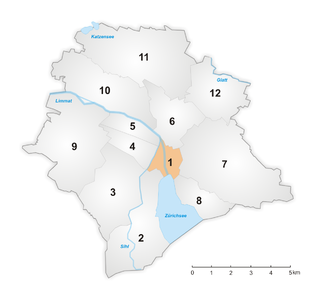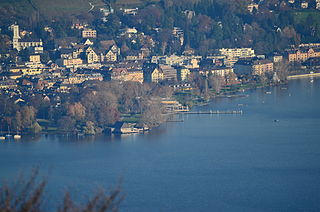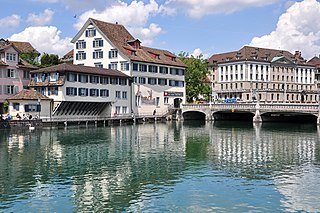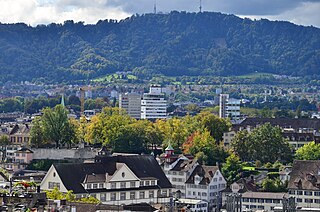
The Altstadt in the Swiss city of Zurich encompasses the area of the entire historical city before 1893, before the incorporation of what are now districts 2 to 12 into the municipality, over the period 1893 to 1934. Die Altstadt approximately corresponds to the area enclosed by the former city ramparts, and is today within the administrative area of the city called Kreis 1.
Zürich was an independent (reichsfrei) city or city-state from 1218 to 1798. The town was fortified with a city wall from the 13th to the 17th century, and with more elaborate ramparts constructed in the 17th to 18th century and mostly demolished in the 1830s to 1870s.

Schipfe is a residential district in Zurich, Switzerland, located on the eastern slope of the Lindenhof, one of the oldest parts of the Helvetii Oppidum Zurich-Lindenhof, by the river Limmat. Historians and the Weinplatz suggest that the district was part of the former civilian harbour of the Celtic-Roman Turicum.

Lützelau is an island located, with the neighbouring island of Ufenau, in Lake Zürich in Switzerland between Rapperswil and Freienbach.

The Lindenhof is a moraine hill and public square in the historic center of Zurich, Switzerland. It is the site of the Roman and Carolingian era Kaiserpfalz around which the city has historically grown. The hilltop area—including its prehistoric, Roman, and medieval remains—is listed as a Swiss heritage site of national significance.

Zürichhorn is a river delta on Zürichsee's eastern shore in the lower basin of the lake. The area is part of the parks and quays in the Seefeld quarter of the city of Zürich in Switzerland. The gardens are one of the most popular recreational areas within the city of Zürich.

Rüti Monastery was a former Premonstratensian monastery, founded in 1206 and suppressed in 1525 on occasion of the Reformation in Zürich, situated in the municipality of Rüti in the canton of Zürich, Switzerland. The monastery's church was the final resting place of the Counts of Toggenburg, among them Count Friedrich VII and 13 other members of the Toggenburg family, and other noble families. Between 1206 and 1525, the monastery comprised 14 incorporated churches and the owner of extensive lands and estates at 185 localities.
The following is a timeline of the history of the municipality of Zürich, Switzerland.

Gustav Gull was a Swiss architect. He designed the Swiss National Museum for which marked a breakthrough in his architectural career.

Turicum was a Gallo-Roman settlement at the lower end of Lake Zurich, and precursor of the city of Zurich. It was situated within the Roman province of Germania Superior) and near the border to the province of Raetia; there was a tax-collecting point for goods traffic on the waterway Walensee–Obersee-Zürichsee–Limmat–Aare–Rhine.

Grimmenturm is a medieval tower and restaurant situated at Neumarkt in Zürich, Switzerland.

The Predigerkloster was a monastery of the Dominican Order, established around 1234 and abolished in 1524, in the imperial city of Zurich, Switzerland. Its church, the Predigerkirche, is one of the four main churches in Zurich and was first built in 1231 as a Romanesque church of the then Dominican monastery. In the first half of the 14th century it was converted, the choir rebuilt between 1308 and 1350.

Rathausbrücke is a pedestrian bridge which crosses the river Limmat in Zurich, Switzerland. It is colloquially named Gmüesbrugg, and is a popular public square connecting Limmatquai, and the Weinplatz plaza and the historical Schipfe quarter.

Oetenbach was a Dominican nunnery in the medieval municipality of Zürich in Switzerland. Oetenbach was named after the small stream of the same name at its first location at Zürichhorn, situated outside of the European Middle Ages town walls, but moved to the present Sihlbühl. The nunnery was abolished on the occasion of the Reformation in Zürich – the Waisenhaus building is its only remaining structure, now the headquarters of Stadtpolizei Zürich.

Central is a public square at the northern end of Limmatquai in Zürich, Switzerland. It is one of the city's public transport nodes, housing an interchange station for tram and bus lines run by the Verkehrsbetriebe Zürich. It was formerly known as Leonhardplatz or Leonhardsplatz.

Bahnhofbrücke is a road and tramway bridge over the Limmat in the city of Zürich in the canton of Zürich in Switzerland.

Lindenhof is the present name of the large fortified settlement, or oppidum, likely founded by the Helvetii on the Lindenhof hill on the western shore of the Limmat in Zurich, Switzerland.

Augustinerkirche was once one of the five main churches in the old town of Zürich, Switzerland, together with Fraumünster, Grossmünster, Predigern and St. Peter's. First built around 1270 as a Romanesque church belonging to the Augustinian abbey, on occasion of the Reformation in Zürich worship in the church was discontinued. The present Christian Catholic Church community of Zürich planned to rebuild the building to commemorate the old Augustinian church, and for the same reason, Augustinerkirche is still their Parish church, that was rebuilt in 1843/44 by Ferdinand Stadler. In the late 1950s, the church was rebuilt in accordance with the plans for the original structure. Today the building is one of the three medieval churches in the Lindenhof district of the city of Zürich.

Augustinerkloster was one of the eight monasteries within the medieval city of Zürich in Switzerland. It was founded around 1270 as an Augustinian Order priory on the site of the present Augustinerkirche Zürich on Münzplatz, and was abolished in 1524.

The Reformation in Zürich was promoted initially by Huldrych Zwingli, who gained the support of the magistrates of the city of Zürich and the princess abbess Katharina von Zimmern of the Fraumünster Abbey, and the population of the city of Zürich and agriculture-oriented population of the present Canton of Zürich in the early 1520s. It led to significant changes in civil life and state matters in Zürich and spread to several other cantons of the Old Swiss Confederacy, and thus initiated the Reformation in Switzerland.






















